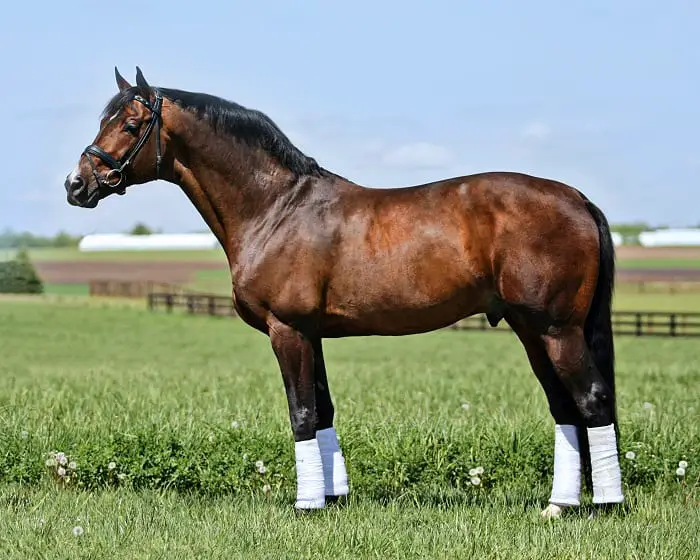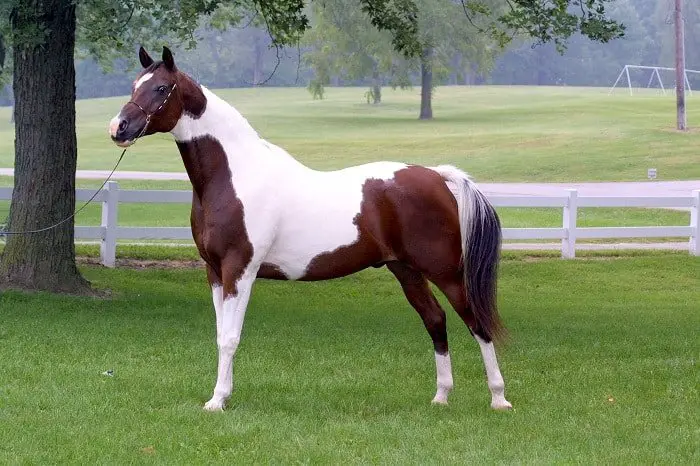Last Updated on November 23, 2021
“That horse has great conformation!” Every equestrian has heard this phrase, but what exactly does it mean? A horse looks nice, does that mean it has good conformation? Horse conformation is a very misunderstood concept in the equestrian world, and in this article, I hope to help debunk it for you.
Good vs. bad conformation isn’t as simple as black vs. white. Conformation is subjective and often depends on the eye and experience of the trainer or buyer. “Good conformation” depends on what the horse’s intended purpose is, and it depends on the way the horse is built as a whole. There are also some objective conformation flaws that horses may possess, although the importance and severity of these flaws will be dictated by the horse’s intended occupation
What is Horse Conformation?
Conformation is a fancy term to describe the way a horse is built anatomically. It is the way a horse’s bones are shaped, bent, and structured. A horse with “good conformation” has few anatomical flaws; its body is shaped the way one would expect. A horse with “bad conformation” has some kind of a significant flaw.
Again, good and bad conformation are highly subjective. But, generally speaking, good conformation indicates a horse has a fairly regular bone structure, and bad conformation indicates that a horse has some kind of objective flaw in its skeletal structure.
Conformation by Discipline
The quality of a horse’s conformation depends on what you expect the horse to do. Broadly speaking, certain horse types are built for specific jobs; not all horses are created equal, and not all horses can perform in all disciplines.
For example, the anatomical structure of a Draft horse is different from that of an Arabian. But, Arabians can’t haul carriages up and down hills and draft horses can’t compete in endurance competitions. The conformation of the horses is very different, but each can excel in different disciplines.
Horses are bred with conformation in mind. Certain anatomical qualities are desired in certain breeds, and horses are bred that are expected to produce horses with these qualities. But, these qualities will vary from breed to breed and from owner to owner.
Conformation by Horse
As famous showjumper John Madden says in his interview with the Practical Horseman magazine, conformation is best judged by looking at each horse individually. Yes, there are some objective conformation flaws that will always be considered “bad,” but many abnormalities can be nonissues due to a horse’s overall conformation.
For example, the angles of a horse’s hocks may be slightly abnormal. Taken by itself, the hocks may be considered to have bad conformation. But, maybe that same horse’s feet may have a slightly abnormal angle that, coupled with the abnormal hock angle, makes the leg angles as a whole correct.
This is just a hypothetical example, but situations like this occur all the time in judging a horse’s conformation. That is why it’s important to examine the entire horse before making a judgment call on whether its conformation is good or bad.
Common Horse Conformation Issues
While good or bad conformation is first dependent on intended discipline and overall body structure of a horse, there are some obvious conformation flaws that horses can have. These include, but are not limited to “knock knees,” club foot, pigeon-toes, splay foot, and straight hind leg.
Knock Knees
“Knock Knees” occurs when a horse’s knees are skewed outward. If a horse has this condition, it is apparent from the time they are a foal. It can be fixed through surgery when a horse is a foal, and it can be remedied further by proper shoeing and farrier work.
But, if a horse doesn’t have corrective surgery as a foal, they cannot have it as a mature horse and must only be treated through corrective farrier work. Knock Knees can cause a horse to have severe muscle and ligament strain on the inside of their legs, as they are being stretched abnormally.
Club Foot
Club foot occurs when a horse has one foot that is abnormally sized. Club foot can come in many levels of severity; it can barely be noticeable and it can cause a horse to be lame for life. A horse’s club foot can be longer, taller, or wider than all of the others. The only way to remedy club foot is with corrective farrier care.
Pigeon-Toes
Pigeon-toed horses are the same as pigeon-toed people; their feet curve into each other. Again, this can happen in varying degrees of severity. Special corrective farrier care can help pigeon-toed horses, but it is important not to over-adjust a horse’s angles. Over-adjusting can lead to additional health issues and lameness.
Splay-Foot
Splay-footed horses have the opposite problem of pigeon-toed horses; their hooves point to the outside. Splay-foot is significantly less impactful on a horse’s natural gait than club foot of pigeon-toes. Corrective farrier work can help but is often not necessary.
Straight Hind Limb
Straight hind limb is exactly what it sounds like; a horse’s back legs are significantly more straight than they should be. A horse’s back legs are naturally bent inwards, and when they are not, they are hyperextending many joints and are more likely to suffer from suspensory and ligament injuries.
Workload and work type must be monitored for horses with a straight hind limb. Disciplines, where a horse’s weight must rock back onto its hind end, will be very strenuous on these horse’s hind legs and can lead to lameness and unnecessary injury. Also, keeping horses with straight hind limb shod on all four feet, all year round can help decrease injury and stress.
Conclusion
Horse conformation is judged very subjectively depending on the horse’s breed, the horse’s intended occupation, and the eye of the trainer or buyer. Some objective conformation flaws exist, but, for the most part, can be corrected through special care. I hope this article helped clear up some of the ambiguity around horse conformation, and the differences between good and bad conformation. If so, please share this article, and share with us your experiences with horse conformation!
FAQs
Why is conformation important in horses?
Conformation refers to horse's body form and size, and how horse's skeleton, muscles and fat are connected to horse's body.
Horses are born with their conformation, which does not change as the horse ages. It is possible for horses to grow and develop over time, especially if they are young or underfed, but such changes do not alter the horse's core size and shape. This innate conformation often relates to an individual horse's breed and genetic background.
Conformation is important for horse's health because horse have to carry themselves and their rider in everyday activities. A horse with poor conformation will typically need extra help from its rider in order to move correctly during various gaits and horse activities.
Is a long back bad for a horse?
A horse with a long back has very good potential for speed, athletic ability and jumping performance. On the other hand, a horse with a short back is normally not as fast and athletic because it often lacks flexibility.
However, because horse's skeleton and muscles are connected to horse's back, a long back can sometimes put horse at risk of developing various skeletal and muscle problems. A horse with back pain may move stiffly and horse may not be able to carry its rider properly without additional help from the rider.
What are three conformational faults in a horses legs?
- A horse with "cow hocks" is too closely coupled. This horse has short pasterns and a short, broad back.
- Horses that are "base narrow" have excessively wide knees and feet that point outward.
- Horses with "post legged" or "sickle hocked" legs stand with their hind legs behind the horse's body. This horse also has an excessively sloped croup.
Can bad conformation cause problems?
Poor horse conformation can cause a horse to have problems as he grows and develops.
Horses with good conformation usually have fewer health problems than those with poor conformation, but it is difficult to predict whether a horse will have health problems just by looking at his body.
The horse's legs are especially important because they bear all of the horse's weight. Problems in horse leg conformation can include bowed tendons, bone spavin, splints, ringbone and weak pasterns.
Poor horse conformation also affects horse riding. However, tying conformation quality with horse riding quality is hard to do. An experienced horse handler might be able to tell if a horse is uncomfortable in his saddle, but this is often difficult for inexperienced horse handlers to see.
Horse conformation can also harbour problems that are not visible on the surface. These "hidden" problems include bone and joint disorders such as arthritis and horse colic.
A horse with poor conformation is also less likely to be able to perform well on a racetrack or at horse shows.
Should you buy a horse with bad conformation?
A horse with poor conformation might be inefficient and uncomfortable to support its rider.
If you plan to ride horse on a regular basis, your horse's conformation is important because it determines how horse will perform and move.
However, if you plan to buy a horse primarily as a companion or for pleasure riding, then bad horse conformation is not a serious issue.
Many horse lovers prefer horse with good horse conformation because it is common for such horse to have better athletic ability and move naturally. However, horse with bad horse conformation can still display excellent athletic ability if he had proper training.
Michael Dehaan is a passionate horse owner, horse rider, and lover of all things equine. He has been around horses since he was a child, and has grown to become an expert in the field. He has owned and ridden a variety of horses of different breeds, and has trained many to compete in shows and competitions. He is an experienced horseman, having worked with and competed many horses, including his own. He is an active member of the equestrian community, participating in events and teaching riding lessons.


